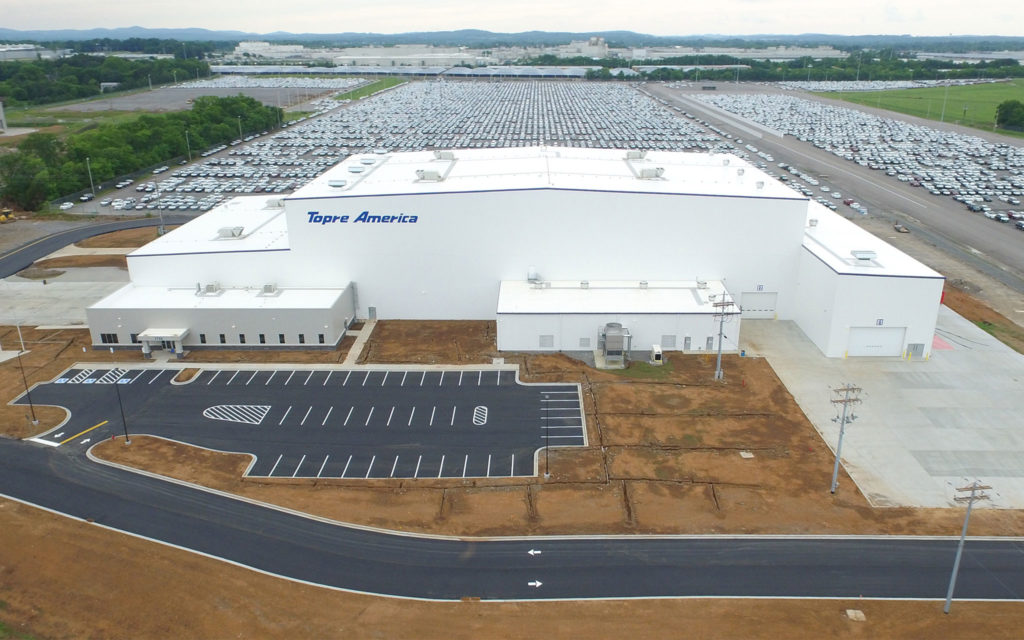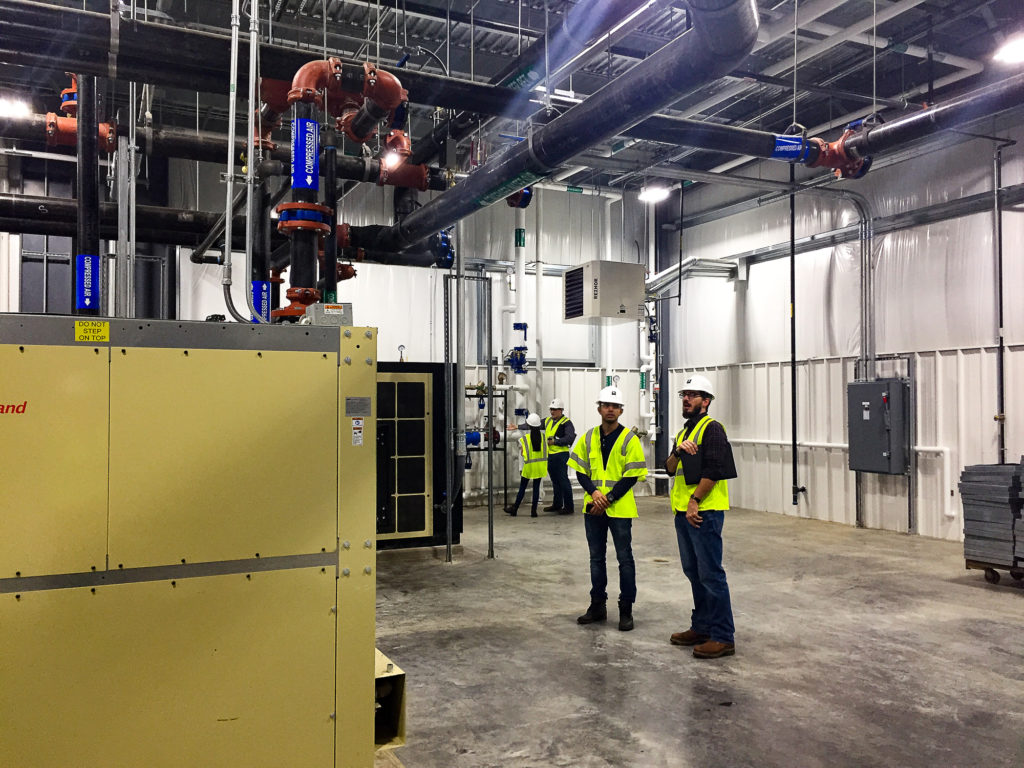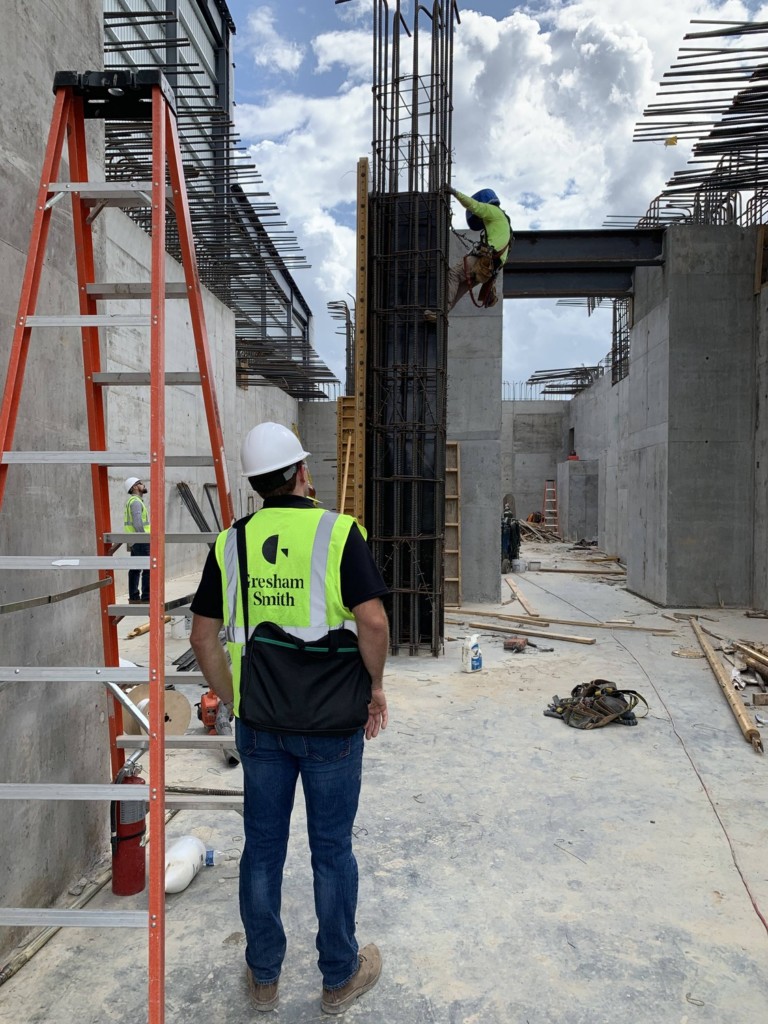Topre America Corporation, the North American affiliate of the Japanese-based Topre Corporation, specializes in metal stamping for high-strength automotive components. Our relationship with Topre—pronounced toe-pray—began in 2015. It all started when Gresham Smith was approached to see if we could take a partially completed design for an 84,000-square-foot stamping plant in Smyrna, Tennessee, that was behind schedule and over budget, and finish the set of construction documents, save the schedule, and get the cost of the project under the owner’s budget.
We had a lot to learn about this new client in a very short time, which is not uncommon when it comes to working on Industrial projects. Time to market and supporting equipment delivery dates are the two biggest drivers in our aggressive schedules. And, as they are almost always set well in advance, it didn’t leave us much time to gain a deeper understanding of Topre and how they operated. Nonetheless, we managed to save the client money and complete the project on time while delivering a high-quality design.
The successful completion of Topre’s first greenfield project in Tennessee set the stage for Gresham Smith to deliver five years of continuous construction projects for the auto supplier as they rapidly expanded their production capacity.
As I look back on supporting the design and construction needs of a client who is experiencing explosive growth, although exciting, I realize it’s not the ideal environment for managing the three key project factors: schedule, quality, and cost. This is especially true if the design team isn’t familiar with the client, their previous projects, the existing site, their equipment, and so on.
In this post, using our work with Topre America Corporation as a case study, I explore the benefits of keeping the same design team when it comes to controlling a project’s schedule, quality, and cost.
Schedule: It’s a Matter of Trust
Reliable, consistent results are the biggest advantage to an owner using a design team for multiple projects. Knowing a client’s preferences, production work flow, and review processes allows the team to anticipate and react more quickly to changes or issues that may arise.
For example, when Topre started their most recent plant building in Tennessee, they idealized a relaxed schedule through design, with ample review meetings and time built-in for them to make decisions.
As the project took form, its delivery date changed due to Topre’s need to more urgently deliver product to market. This expedited the press and crane delivery dates, which required the building design and construction activities to be shortened from 16 months to around 13 months.
This abrupt change certainly presented a major challenge, since plans were already well underway based on the original schedule. To support this sudden transition to a very aggressive project schedule, we quickly reworked our project plan to require fewer and shorter owner-review periods. We also added several early release packages for architecture as well as civil, structural, and electrical engineering.

Topre America Corporation Stamping Plant, Smyrna, Tennessee.
Had the design team not already known many of Topre’s preferences and understood their past decisions, we would have been bogged down with long lists of questions and needs from the client. There is no way the same schedule reduction would have been possible.
Similarly, had the owner not worked with our design team over a five-year period, they wouldn’t have known they could trust us to incorporate past decisions and catch even the smallest of details about their existing site as the early release packages were rapidly going out the door. The project’s success suddenly, and more than ever, relied on trust—trust that had fortunately existed for years.
Because the owner and the design teams were familiar with one another, the groundwork for cooperation and problem-solving was already laid, which allowed the team to focus on solutions rather than wasting time trying to get on the same page. Using a consistent design team gives the client a completely different framework for their project, allowing a greater amount of flexibility.
Change, of course, is inevitable on any project. Still, a project’s success or failure ultimately depends on a team’s ability to work together. The hallmark of strong, well-established client/design team relationships is their ability to adapt and succeed.
Quality: Adding Value
Using a consistent design team for repeat work brings a client additional value to their project in many different ways. In addition to the value found in reducing project durations, we have also been able to reduce the level of effort required from Topre, while producing consistent, reliable deliverables, and using past experiences and lessons learned to greatly increase the return on investment for continuous improvement.
This provides a huge advantage in addressing one of the constant themes we see repeated from project to project: The urgent need for information from the owner. Whether it’s equipment information, production layout, decisions on fixture selections or other critical design decisions, there is always a long list of information demands that we put on our clients.
After working on numerous projects with Topre, we have reduced that list tremendously, freeing up the owner’s project management team to focus on other important aspects of the project, such as purchasing equipment or working with in-house engineering and operations staff to prepare for production.

Using a consistent design team for repeat work brings a client additional value to their project in many different ways.
We didn’t need to ask the same questions again or revisit past decisions. There was no delay in starting design, because we had gathered relevant information on previous projects. Time typically spent trying to gather this information, and more importantly the time we spend understanding it, was saved and reallocated to value engineering and other project improvements for the owner.
On Topre projects, we have adopted a consistent set of specifications and have standardized our drawing content. This allows us to generate better defined scopes of work for the contractors to bid and construct the work, while allowing for easier checks to ensure consistency with past projects.
Additionally, decisions made on a project can easily be carried forward to the next project, reducing the number of RFIs and strengthening the coordination between the different discipline’s design documents.
Cost: Spending More Time in the Details
When reductions in schedule and increases in quality are not enough to justify a decision that is coming down to their bottom-line, owners will also see significant cost savings using a consistent design team for their various projects. We are able to provide the owner a reduction in the design fee related to reductions in project duration and the limited amount of new information that the design team has to learn.
Both of these factors yield immediate savings to the client when they rehire a design firm for a new project. However, design fees alone do not contribute significantly to the overall reductions in project costs.
The most appreciable savings an owner will see in using a consistent design team are the reductions in the cost of construction. A design team who knows a client well will reduce the number of owner-requested changes, because they will have anticipated the change, discussed it with the client during design, and updated the contract documents before anything is sent out for bid.

The most appreciable savings an owner will see in using a consistent design team are the reductions in the cost of construction.
As the design team is able to spend more of their time refining the project details, since many of the major decisions and discussions have already taken place on past projects, the final contract documents are naturally a tighter set of design requirements and directions to the contractor. The less a contractor has to guess, the better their quotes will be.
Faster, Better, Lower
By consistently using the same design team on their projects, Topre has achieved aggressive schedules while maintaining control of their budget and building quality. This was successfully accomplished because the design team shortened the learning curve, reduced the demand for information from the client, and eliminated surprises.
This formula for success is available for any client performing multiple projects in succession. As we have experienced with Topre, ultimately, keeping the same design team results in a faster schedule and a better quality product delivered at a lower cost.
